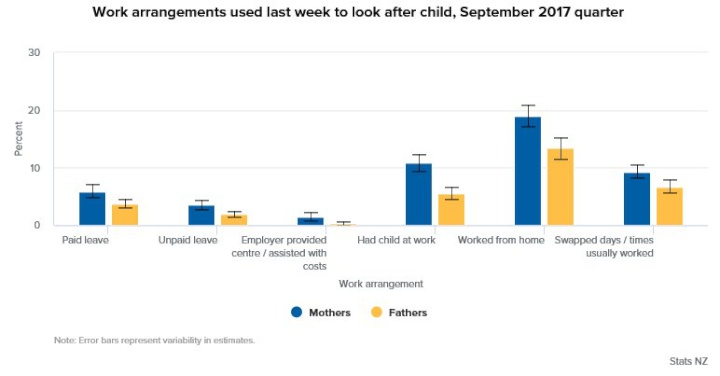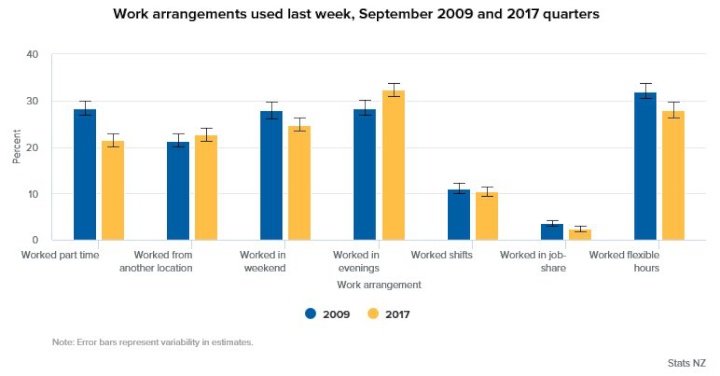Working from home helps with childcare
The most-common work arrangement used by parents to help
care for a child in 2017 was to have worked from home (16
percent of all parents), Stats NZ said today. This was
followed by having a child at work, and swapping the days or
times usually worked (8 percent for both).
“Working parents use different arrangements to help balance their work and childcare needs. Increasingly flexible employers, and technology may play a part in helping parents manage their care arrangements alongside work commitments,” labour markets and household statistics senior manager Jason Attewell said.
The Childcare in New Zealand survey, a supplement to the Household Labour Force Survey, asked parents of children 13 years and younger about the care arrangements used for their children, as well as information related to the parents’ work and study.
Employed parents were asked whether they had used any of a group of work arrangements in the previous week specifically to help look after a child. Of the 743,700 employed parents in 2017, 28 percent had used at least one of the arrangements asked about to help care for a child. More mothers than fathers had used an arrangement, 35 percent compared with 23 percent, respectively.

Mothers were more likely to have used all arrangements than fathers. The largest differences in the arrangements used by mothers and fathers were in the proportions who had worked from home, or had a child at work. The proportion of mothers who had a child at work decreased from 14 percent in 2009 to 11 percent in 2017.
In 2017, paid leave was used by 4.8 percent of parents in the week before the interview to help with childcare, while 2.6 percent used unpaid leave. This has not changed since 2009. The most-common type of paid leave used was annual leave.
European parents were more likely to have worked from home to help care for a child compared with Māori, Pacific, and Asian parents.
Employed parents were also asked about their use of more general work arrangements in the week before the interview. While asked of parents, these arrangements were not specifically linked to childcare. The most-common arrangement used by all employed parents in 2017 was to have worked in the evening (32 percent), followed by working flexible hours (28 percent). In 2009, working flexible hours was the most-common arrangement (32 percent).

“More parents worked in the evening in 2017 compared with 2009, and there was a drop in those working flexible hours and part-time hours,” Mr Attewell said.
Mothers were significantly more likely than fathers to have worked part time in the week before the survey, while fathers were more likely to have done weekend and evening work. The proportion of employed mothers who worked part-time hours dropped from 50 percent in 2009 to 37 percent in 2017.
By ethnicity, employed European parents were most likely to work from another location, such as home, and least likely to have worked shifts compared with the other three main ethnic groups looked at.
Definitions and metadata
New Zealand Childcare Survey – DataInfo+ provides general methodology used to produce these statistics and related metadata, including definitions of concepts.


 Gordon Campbell: On The Clash Between Auckland Airport And Air New Zealand
Gordon Campbell: On The Clash Between Auckland Airport And Air New Zealand NZ Government: Repeal Of 7AA Puts Child Wellbeing First
NZ Government: Repeal Of 7AA Puts Child Wellbeing First NZ Government: Reducing Ambiguity About What Is Reasonably Practicable For Health And Safety Compliance
NZ Government: Reducing Ambiguity About What Is Reasonably Practicable For Health And Safety Compliance Office of the Speaker: New Zealand Parliamentarians Attend 150th IPU Assembly
Office of the Speaker: New Zealand Parliamentarians Attend 150th IPU Assembly RNZRSA: RNZRSA Supports Willie Apiata VC's Stand To Drive Change To Veterans’ Support Act
RNZRSA: RNZRSA Supports Willie Apiata VC's Stand To Drive Change To Veterans’ Support Act Diane McCarthy - LDR: War Hero Willie Apiata Entrusts MP With Victoria Cross Medal
Diane McCarthy - LDR: War Hero Willie Apiata Entrusts MP With Victoria Cross Medal PSA: Disappointing Govt Attack On Diversity, Inclusion In Public Service
PSA: Disappointing Govt Attack On Diversity, Inclusion In Public Service


